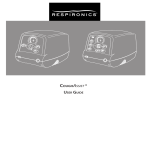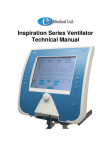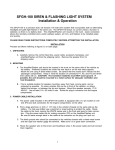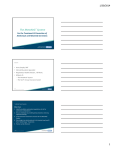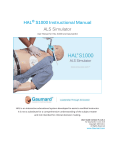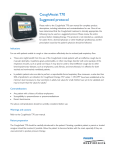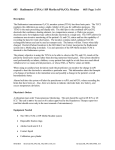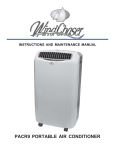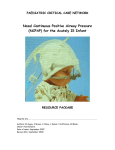Download 310 01_PhilipsV60
Transcript
310.2 Philips V60 NIV Description BiPAP therapy is only appropriate in the ED, Critical Care and Transitional Care Units. The decision to administer BiPAP in any other general care area must be approved by the RCS Medical Director NOTE The BiPAP device is not designed for continuous long term mechanical ventilation and, should not be used on intubated or trached patients that are entirely ventilator dependent. Use of BiPAP is appropriate for intermittent ventilatory assistance in patients that are capable of spontaneous ventilation. Goals of NIV: Alleviate respiratory distress by: • Improving gas exchange • Reducing WOB • Decrease rapid shallow breathing • Augmenting alveolar ventilation • Achieve patient-to-ventilator synchrony • Reverse atelectasis • Minimize risks and avoid complications associated with endotracheal intubation Indications for Instituting NIV by Disease State Best • • • • COPD exacerbations Acute cardiogenic pulmonary edema Respiratory failure associated with immunosuppression Obstructive sleep apnea (OSA) Acceptable • Hypercapnia associated with neuromuscular disease/chest wall deformity • Respiratory distress in patients classified as DNR/DNI (palliative care consult) Not Appropriate (except as a temporizing measure in the period immediately prior to transfer to ICU). These being situations when respiratory distress is associated with: • • • • Asthma exacerbation ARDS Pneumonia Chest trauma Adopted: 4/2015 1 2 310.2 Philips V60 • • Post-operative period Obtunded, airway protect issues Contraindications for NIV in all care areas • • • • • • • • • • • • • • • • • • Head or facial fractures Obtunded/ unable to protect airway (or remove mask) Basilar skull fracture Cardiac/Respiratory Arrest Untreated Pneumothorax Tracheal or bronchial fractures High Risk for Aspiration Systolic BP < 90 mm Hg (resistant to fluids) Bullous lung disease Sinus or middle ear infections Uncontrolled Arrhythmias CVA Seizures Unable to Cooperate Unable to Fit Mask Severe Upper GI Bleed Patient inability to remove mask (i.e. in case of vomiting) Multi-Organ System Failure Physiologic Indices for NIV Gas Exchange Criteria • Hypercapnic Failure: pH < 7.35 with PaCO2 > 45 mm Hg • Hypoxemic Failure: PaO2/FiO2 < 200 mm Hg Breathing Pattern: Evidence of Moderate to Severe Respiratory Distress • • • • • Tachypnea (due to COPD / hypercapnic failure): RR > 25 Tachypnea (due to Acute hypoxemic respiratory failure): RR > 30 Dyspnea (subjective) Pronounced accessory muscle use Paradoxical breathing Physician's Order The administration of BiPAP (NIV) therapy (face mask pressure support) must be approved by a physician. A written order must be present in the patients chart before therapy is instituted. The order must state the IPAP and EPAP level used, the mode of operation, the frequency and duration of treatments, and acceptable pulse oximetry saturation. 2 310.2 Philips V60 NIV Philips Respironics V60 The BiPAP V60 ventilator is a microprocessor controlled, bilevel positive airway pressure ventilatory assist system providing noninvasive PPV and may be used as invasive ventilator support for spontaneously breathing adults and pediatric patient’s ≥ 20kg. The V60 system incorporates a user interface, real time graphic displays and integral patient and system alarms. This system operates in the Continuous Positive Airway Pressure (CPAP) and Pressure Support, Spontaneous Timed (S/T), Pressure Control Ventilation (PCV), Average Volume Assured Pressure Support (AVAPS) & Proportional Pressure Ventilation (PPV) modes. Pressure regulation is achieved by monitoring proximal airway pressure and adjusting flows to ensure that the set pressure equals the proximal pressure. The V60 ventilator is an assist ventilator intended to augment ventilation of a spontaneously breathing patient. It is not intended to provide the total ventilatory requirements of the patient. The V60 is FDA approved for noninvasive and invasive ventilation. The exhalation port test is no longer required unless the PEV or an unknown exhalation valve is used. The V60 circuit/interface requires an intentional leak port instead of an actively controlled exhalation valve to remove exhaled gases from circuit. The pressurized air from the V60 causes a continuous flow of air to exhaust from the leak port, flushing exhaled gas from the circuit. The Respironics mask and/or exhalation port must contain a CO2 removal port to decrease an occurrence of CO2 rebreathing. Principles of Operation Oxygen Module regulates and proportions O2 into the air from the blower according to the oxygen concentrator level set on the parameters screen. O2 range from .21%-100%. The higher the oxygen concentration settings, the higher the oxygen flow rates required from the oxygen module and the lower the air flow rate from the blower. In the event there is no access to a 50 psi source, O2 can be bled into the circuit using oxygen connection tubing connected to an oxygen flowmeter and a pressure line adapter connected at the patient interface port. Adopted: 4/2015 3 4 310.2 Philips V60 V60 Performance Capabilities: Auto Trak Sensitivity description: • An algorithm that adjusts to changing leak conditions to achieve optimal patient-to-ventilator synchrony • Auto adaption leak compensation • Auto-adaptive I-trigger adjustment • Auto-adaptive E-cycle adjustment For a more in depth understanding of Auto Trak Sensitivity algorithm, see description at the end of this document or refer to the user’s manual. Monitoring: • Pressure, flow, Volume waveforms • Visible and audible alarms • Breath type (spontaneous, timed) and breath phase (inhalation, exhalation) • Total breath rate • Tidal volume and minute volume • PIP • Leak: patient or total • Percent patient triggered breaths • Ti/Ttot Pressure Ulcer: A pressure ulcer is a localized injury to the skin and/or underlying tissue, usually over a bony prominence as a result of pressure, or pressure in combination of shear and/or friction. Pressure ulcers are areas of tissue destruction due to ischemia. California Department of Public Health (CDPH) requires that the following hospital acquired pressure ulcers (HAPU’s) are reported within five days of discovery: A. Stage III B. Stage IV C. Unstageable D. Deep Tissue Injury is reported if it converts to a Stage III, IV or Unstageable Patients requiring NIV therapy are at high risk for Hospital Acquired Pressure Ulcers: RCS is responsible for the monitoring, prevention, documentation and reporting HAPU’s. Refer to the SFGH Nursing Department Policy No: 20.9 for an in depth description of the Braden Score Assessment Tool and how pressure ulcers are staged. 4 310.2 Philips V60 NIV o The % Patient Leak or % Total Leak must be documented in the patients EMR or Cardiopulmonary Flow sheet o Any redness, blisters, broken skin or rashes, notify RN immediately. o To improve pt. comfort and or reduce HAPU’s, insure leak is in the 7-25 lpm range. o Consider alternate mask or alternating masks if possible. The V60 is intended for patients (>20kg) In the event NIV is required for patients weighing < 20 kg (44lbs): • Covidien 980 – NIV Pediatric Mode • Carefusion Infant SiPAP: Infant or neonatal application, refer to the Infant SiPAP Policy and Procedure No. 312 Transport: The Battery The internal lithium battery, when fully charged, is capable of sustaining ventilation for at least 6 hours. Transport: The Tanks The V60 comes ready to equip two auxiliary gas tanks for use during patient transport. No gas source is required due to the V60’s internal blower. Grab and go tanks are capable of flow delivery up to 100L/min. Bench testing the ventilator with a VE of 12L/min, FiO2 of 1.0 and two full E-cylinders of O2 yielded roughly 40 minutes of usage per tank. Your results may vary but regardless of the distance to be traveled or the FiO2 in use, always bring an extra tank just in case! (See calculation below.) (Tank pressure in PSI - 200) x 0.28 cylinder factor ______________________________________________ = Time until empty Flow rate L/minute Adopted: 4/2015 5 6 310.2 Philips V60 Theory of Operation: For patient safety, the ventilator starts up in the same modes and settings including mask type and leak port as when last powered down. In the event the wrong mask and or port setting are selected, Total Leak rather than Pt. Leak will be displayed in the patient data window In the event the wrong mask/port are selected: • • Vt and leak monitoring accuracy will likely be affected Breath synchrony and breath delivery may be adversely affected • After Self-Test is complete, if necessary, the Start-up screen allows clinician to perform the Exhalation Port Test” which analyzes the leak rate of the exhalation port. During the test the system measures the intentional exhalation port leak over the complete pressure range. • Respironics masks have their leak number imprinted on the mask making it easy to make the proper selection. If you are not using a Respironics mask, you need to choose “other” when setting the interface preference. • If an exhalation port is not compatible with the selected interface, V60 will not allow that choice and will be displayed on the screen. • ET/trach tubes and most Respironics masks require use of an exhalation port. You may not select “None” as a port choice. • When selecting an exhalation port, a picture of the port will appear by the name of the port selection. If you choose DEP or the Whisper Swivel, no exhalation port test is needed. If you choose PEV or other, an exhalation port test will be required (PEV no longer supplied at SFGH) Equipment • At no time should V60 be used without an expiratory port! o This is not to be confused with the anti-suffocation feature found on the AF531 BiPAP masks/elbows! Bacteria filter – Protects patient and ventilator from contamination – Attach low resistance filter to the gas outlet port – Must be in place prior to exhalation port test • • 6 Humidifier Chamber 310.2 Philips V60 NIV o (Insure Humidifier is in Non-Invasive mode) o HME’s are never to be used with NIV as they increase resistance. • Sterile H2O bag • Temperature probe • Disposable Exhalation Port adapter (DEP) • Heated wire circuit: o The F&P R219 BiPAP circuit is the device of choice. o RT219 package includes the DEP, heated wire circuit, dry inspiratory limb, MR290 chamber and the pressure line tubing. • Mask Interface: o Fitting the mask to the patient’s face is key to ensuring successful NIV therapy with appropriate leaks that will allow the mask to “float” on the patient’s face to provide positive pressure and at the same time, eliminate any possibilities of device related pressure ulcers. o The patient and the RN will be instructed on intentional leaks and the risks of a mask that does not allow for a patient leak of at least 7L/min. The Auto-Trak algorithm will easily compensate for leaks possibly up to 60 lpm. Adopted: 4/2015 7 8 310.2 Philips V60 Mask Interface options: SFGH RCS uses the Philips AF531 and PerforMAX NIV mask collection only. When integrated with the Philips V60, this mask platform allows for the real-time calculation of patient leak based on a known constant leak of the mask elbow you’ve selected. 8 310.2 Philips V60 NIV Mask Elbow Options: The Philips AF531 platform features removable elbows which allow for quick customization of the mask to fit the needs of the therapist at the bedside. SFGH will supply 4 different elbows for use with these masks: Clear #1 Leak Elbow • Included with the oro-nasal mask. • Integrated anti-suffocation valve Amber #2 Leak Elbow • Included with the PerforMAX mask. • Integrated anti-suffocation valve Green Bronchoscopy Elbow • Specialty elbow designed to improve ease of bronchoscopy procedures while on BiPAP • Replace with clear or amber elbow upon completion of bronchoscopy Blue Solid Elbow • NOT TO BE USED WITH THE V60 o This elbow is for double limb ventilators like the PB980 • No leak present Why use a total Face Mask? • Mouth breather, claustrophobic, • Level of consciousness • Patient cooperation • Sizing is effortless. Air Leak Recommendations: Minimal air-leaks are highly recommended If the leak is < 7 lpm, the mask may be too tight resulting in skin breakdown or necrosis. 0-6 L/min = May be too tight 7-25 L/min = Just right 26- 60 L/min = Caution and Monitor > 60 L/min = Adjust These are Philips recommendations, the clinician needs to assess and reassess to determine proper mask size, fit and appropriate leak based on the patient’s needs and condition. Adopted: 4/2015 9 10 310.2 Philips V60 Strategies for NIV success: • • • Patients in Acute respiratory failure are usually short of breath, frightened, claustrophobic and may feel like they are suffocating. Applying the mask at therapeutic pressures may exacerbate that feeling. Anxiety will make it difficult for the patient to synchronize with the ventilator. NIV guidelines recommend starting with low pressure of 5 cm H2O, and slowly increase the pressure to therapeutic levels. If feasible, permit the patient to hold the mask to their face until he or she becomes accustomed to the mask and pressures. Coach the patient to relax and let the ventilator assist their breathing. This may take several minutes. The goal during this initial application period is to gain the patient’s confidence and acceptance to NIV therapy. When the patient is ready, apply the headgear and adjust the mask for maximum comfort. Two fingers should easily fit between the mask and the patient’s face. This will help prevent over-tightening of the headgear straps. Small leak around the mask is acceptable but should be directed away from the eyes. If the patient starts batting their eyelashes at you, it is probably due to air blowing in their eyes. This discomfort may result in the patient removing the mask. Failure to tolerate noninvasive ventilation is often due to inability to tolerate the mask. Interface related complications: 10 • Discomfort, air leaks, and nasal bridge ulceration can be minimized or avoided by readjusting the interface, minimizing strap tension, adjusting the forehead bridge, or changing to a total face mask. • • Total Face Mask helps eliminate leaks in pts w/out a full set of teeth, Facial skin necrosis may still occur even if the mask is not exerting high pressure on skin. Consult with the patients RN to treat or prevent any pressure ulcerations or potential breakdown. • Clean patients mask regularly. • • Make every effort to fit the mask to avoid air leaks into the patient’s eyes. SFGH RCS supplies a selection of PerforMax or Oro-nasal masks in all available sizes for both adult and pediatric patient populations. 310.2 Philips V60 NIV Standby Standby suspends current ventilation and retains current settings when the clinician wants to temporarily disconnect the patient from the ventilator. 1. 2. 3. 4. Select Standby. The Entering Standby window opens Remove the patient’s mask. During Standby, changes may be made to alarms, parameters or modes. Standby mode does disable alarms • The ventilator will not enter standby if a patient breath or resistance is detected. • The monitor screen can be cleaned while patient is receiving therapy by activating the Screen Lock. Adopted: 4/2015 11 12 310.2 Philips V60 Mode Selection: Continuous Positive Airway Pressure (CPAP) • CPAP: 4- 25 cmH20 • Ramp time: 5-45 min (allows for gradual increase of pressure for improved patient tolerance as patient relaxes into sleep breathing pattern. • Cflex: Adaptive pressure relief for user comfort. CPAP pressure decreases at the very beginning of exhalation, returning to set pressure before inhalation. The higher the setting option (1, 2 or 3), the greater the expiratory flow, and the greater the pressure relief. Setting 3 being the most comfortable decreasing CPAP to the lowest level. Pressure relief varies based on flow and C-flex setting. (Cflex is only available in CPAP mode) • NOTE: Cflex is not intended as a rescue strategy. It is intended for OSA patients. S/T (spontaneous timed) • Most commonly used: • Standard Bi-level settings o Delivers pressure supported breaths o Patient determines I-time o User defined apnea backup rate (based on respiratory rate and Itime for ventilator breaths only) o Mandatory breaths are only delivered if patients respiratory rate is < set respiratory rate • Rise time o Settings: 1 – 5, “1” being the fastest. o Rise time determines how quickly the pressure will rise from EPAP to IPAP. Adjust to patient comfort (for patients with increased inspiratory flow demands, consider a faster rise time, however, careful assessment and communication with the patient is the optimal method for determining comfort). • 12 Ramp time o Adjusts IPAP and EPAP pressures gradually to allow patient to ease into pressure support. Ramp time allows the clinician to set a specific time for set pressures to be delivered to the patient. o Ramp time range: 5 – 45 minutes 310.2 Philips V60 NIV Pressure Control Ventilation (PCV) Very careful assessment of patient’s respiratory status is to be considered when selecting modes. PCV is not intended for tachypneic or irregular breathing patterns. • • • • Set IPAP and set I-time is delivered Every breath has the same I-time regardless of patient triggered or time cycled breaths PEEP is not compensated: Any changes in EPAP without changing IPAP will change the driving pressure and effect the Vt. IPAP is the PIP Indications: • Patients who have difficulty sustaining a breath • Neuromuscular disorders • CLD • Patients with a normal breathing pattern and respiratory rate with muscle weakness Contraindications: • Patients with tachypnea or irregular breathing patterns – may become dysynchronous with the limitation of a set I-time • Patients with fast respiratory rates • PCV breaths are patient triggered and time cycled. Patient-to-ventilator synchrony may suffer. • Patients with respiratory distress • Setting the appropriate inspiratory time becomes imperative • The patient may fatigue due to increased WOB and decreased patient-to-ventilator synchrony • Potential for Auto-PEEP Adopted: 4/2015 13 14 310.2 Philips V60 Average Volume-assured Pressure Support (AVAPS) AVAPS (average volume-assured pressure support) is a mode that targets a specific tidal volume. It achieves the target volume by regulating the pressure applied following an initial pressure ramp-up. Pressure will ramp up by 1 cmH20 to possible 2.5 cmH20 per minute. This is a very slow ramp up. It is designed to be that way. During AVAPS setup, there may be a period of time before the target tidal volume is achieved. AVAPS should not be used when rapid and frequent IPAP adjustments are needed to achieve the desired Vt. • Algorithm assumes a lung compliance of 60 ml/cm H2O • Vent automatically modifies IPAP pressure to maintain an average targeted Vt • Up to 2.5 cmH2O per minute • AVAPS may underestimate the best starting IPAP • Increase Min P to get there immediately • If target Vt is not achieved, increase Min P until target Vt is achieved. As the Vt reaches the desired level, titrate the Min P • IPAP cannot be < 8 cmH20 (this is the starting pressure) • If P Min is greater than calculated starting IPAP value or 8 cmH20, AVAPS starts IPAP at Min P value. • When changing from S/T to AVAPS o Set Min P the same as the IPAP setting in ST or PCV Allows for quick-start to achieve the target VT o Once target VT is reached, lower Min P slightly (2 to 3 cmH2O) to allow AVAPS to adjust o Set Max P to limit delivered pressure • A Max P above 20-25 cmH20 may not be tolerated by the patient and should be avoided. In AVAPS, the EPAP value is limited to less than Min P-1 cmH20. In other words, the Min P has to be above EPAP in order for the V60 to help achieve the target Vt. A message displayed on the screen will alert clinician to the required change. If the EPAP is increased without an increase in the Min P, the screen will display the corrective action. 14 310.2 Philips V60 NIV What patients could benefit from AVAPS? • Patients with neuromuscular disorders. A patient’s Vt declines as the disease process worsens in standard bi-level therapy. • Restrictive Thoracic Disorders, chest wall deformities, slow progress diseases: AVAPS will gradually assist in achieving the tidal volume. • Obesity Hypo-ventilation syndrome. These patients typically change their body position when they are sleeping. Change in body position can increase airway resistance. Without an increase in pressure support, Vt will likely decrease. • In short, any chronic disease process that is past the acute phase, such as COPD or CHF. Contraindication • Patients in any type of acute respiratory distress, • Increased RAW, • Decreased Cl. • Do not use with nasal mask Proportional Pressure Ventilation (PPV): Not to be used until future training, TBD. • Patient effort determines the pressure, flow, and tidal volume delivered by the ventilator. The ventilator responds to patient effort, allowing the patient to determine when to start and end a breath and how flow and pressure change as the patient inspires • Resistance and Elastance are set and titrated based on the patient’s disease process whether it is of a restrictive, obstructive or mixed disease nature. ALERT: THE PPV MODE IS PROHIBITED FOR PATIENT USE UNTIL FURTHER TRAINING IS PROVIDED. ALARMS Note: Alarm Silence Turns off audible alarm for 2 minutes. If a new alarm condition occurs during this silent moment, a visual alert will appear in Mode/Message Area The alarm settings on the V60 are as follows: • Hi Rate-this ranges from 5 to 90 bpm. • Lo Rate-this ranges from 1 to 89 bpm. Adopted: 4/2015 15 16 310.2 Philips V60 Important note when setting the low respiratory rate alarm: This low rate needs to be set above the Rate Control for mandatory breaths. This is set to notify you when you’re spontaneously breathing patient slows to a RR that would indicate fatigue or stress. There is no said Apnea Alarm, this setting alerts clinician to a potential apnea event 16 • If the patient Respiratory Rate is the same or less than the set rate, the mandatory rate will cycle on. • Hi Vt-range - 200 to 2500ml. • Low Vt-range - Off to 1500ml. • HIP (High Inspiratory Pressure) Alarm-ranges is from 5 - 50cmH20. Set this 5 to 10cmH20 above IPAP • LIP (Low Inspiratory Pressure) Alarm-ranges from Off to 40cmH20. Set this 3 to 5cmH20 below IPAP. • LIP T (Low Inspiratory Pressure Delay Time) – ranges from 5 to 60 seconds. A delay is selected that will alert clinician that the pressure is not achieved. • Low VE (Low Minute Ventilation) Alarm – ranges from Off to 99.0L/min. 310.2 Philips V60 NIV Nebulizer Options and circuit placement: To optimize medication delivery, position nebulizer at patient interface as close to the elbow of the mask as possible. To increase delivery of drug and reduce loss of medication, always place nebulizer , regardless of type, between mask and exhalation valve (See picture below.) If patient is agitated to the point of spilling medication, transition to mini-heart – T in between mask and exhalation valve. Adopted: 4/2015 17 18 310.2 Philips V60 Complications Pneumocephalus has been reported in patients receiving mask CPAP. Patients with a history of head or facial trauma should be carefully evaluated prior to instituting BiPAP therapy. Patients must be ruled out for basilar skull fractures; sinus and facial fractures; and CSF leaks. The presence of any of these conditions is a direct contraindication for the use of nasal or face mask BiPAP therapy. Barotrauma. Pneumothorax, pneumomediastinum, and subcutaneous emphysema are potential complications that may result from BiPAP therapy. If the development of any of these conditions is suspected, discontinue BiPAP therapy and notify the ICU resident. Hypotension. Cardiovascular compromise as a result of positive pressure ventilation is a potential complication that may be associated with BiPAP therapy. If a patient develops hypotension secondary to BiPAP, discontinue therapy and notify the ICU resident. Aspiration is a potential complication especially when administering BiPAP via full face mask. Nausea and gastric distension secondary to aerophagia may be the precipitating factors. Placement of a nasogastric tube may be necessary. If a patient vomits, immediately discontinue therapy, clear the airway, and notify the ICU resident. Pressure Necrosis and Dermatitis. Patients receiving continuous BiPAP therapy by nasal mask or full face mask must be monitored for the development of pressure sores or dermatitis. Patients must be checked for skin reactions secondary to mask pressure at least every four hours. If a patient develops an adverse skin reaction, discontinue therapy and notify the ICU resident and nurse. Patient Accommodation. Patient comfort and cooperation are important considerations for the successful use of BiPAP. To improve patient accommodation the procedure should be thoroughly explained to the patient when possible. If the patient shows signs of poor tolerance (decreased SpO2, increased RR, increased PaCO2), notify primary physician caring for the patient to discuss a more appropriate care decision. Documentation Documentation entries must be made in the patient’s EMR or the Cardiopulmonary Flow Sheet for every BiPAP treatment given, or at least every four hours if BiPAP is administered continuously. Charted parameters should include BiPAP for the mode, FIO2, breaths per minute, set breaths per minute (Timed Modes only), estimated tidal volume, and pulse oximetry values, Pt. Leak. (Pt. Leak will be added to the Cardiopulmonary Flowsheet soon . Please document the patient leak in the (EIP) cell until this document reflects this change) 18 310.2 Philips V60 NIV Charges • Charge for BiPAP Setup for the initial set up, and BiPAP Daily for every day of continuous use. • Charge for each BiPAP circuit change • Hyperinflation Tx should be charged for each intermittent BiPAP treatment used to reverse atelectasis Discontinuation BiPAP should be discontinued per physician's order. For standard disinfection, the body of the BiPAP unit is to be disinfected with hospital supplied 3% Hydrogen Peroxide disinfection wipes. The touchscreen should be cleansed with provided Asepti-HB disinfectant spray and wiped clean with paper towels. Should the device be removed from a C-DIFF isolation room, please use bleach wipes instead. If the black rubber mask strap was used, place in the RCS dirty equipment bin in the 4E utility room. SPD will sterilize. Dispose of all single patient use equipment in the appropriate trash receptacle. Assemble a new circuit. Ensure the device is ready for the next patient and return unit to 4F9 or ED BiPAP storage area. Auto Trak Sensitivity How does the V60 Ventilator recognize and compensate for intentional and unintentional leaks in the system, and automatically adjust its triggering and cycling algorithms performance in the presence of leaks. This is called Auto- Trak Sensitivity? Triggering Breaths are patient (flow) triggered in all modes, typically when patient effort causes a certain volume of gas to accumulate above baseline flow (volume method). An inspiration is also triggered when the patient inspiratory effort distorts the expiratory flow waveform sufficiently (shape signal method; see figure 4-4). Cycling Cycling to exhalation occurs in these cases: • Patient expiratory effort distorts the inspiratory flow waveform sufficiently (shape signal method). See “Shape signal method of cycling and triggering.” on page 4-4. • Patient flow reaches the spontaneous exhalation threshold (SET). See “SET method of cycling.” figure 4-4. • After 3 seconds at the IPAP level (timed backup safety mechanism) • Adopted: 4/2015 19 20 310.2 Philips V60 When a flow reversal occurs, typically due to a mask or mouth leak Shape signal method of cycling and triggering. The shape signal or “shadow trigger” method uses a mathematical model derived from the flow signal. A new flow signal (shape signal) is generated by offsetting the signal from the actual flow and delaying it (Figure 4-2). This intentional delay causes the flow shape signal to be slightly behind the patient’s flow signal. If there is a sudden change in patient flow, the patient’s flow signal crosses the shape signal; this results in a trigger or a cycle. As a result, a sudden decrease in expiratory flow from an inspiratory effort will cross the shape signal and create a signal for ventilator triggering. SET method of cycling. Patient flow reaches the spontaneous exhalation threshold (SET); see Figure 4-3. The SET represents the intersection of the flow waveform and a line of a given slope. SET is updated each breath. Leak adaptation Noninvasive ventilation in particular may involve considerable leakage around the mask or through the mouth. Some leakage is known or intentional: it is a characteristic of the mask/patient interface design. So that it can accurately adjust its baseline flow, the 20 310.2 Philips V60 NIV ventilator has you enter the intentional leakage value specific to the mask/patient interface. Other leakage is unpredictable or unintentional, and it changes as the patient’s breathing pattern changes. To maintain prescribed pressures in the presence of leakage, the ventilator adjusts its baseline flow. Because the unintentional part of the leakage may constantly change, the ventilator recalculates the baseline flow each breath at the end of exhalation. The ventilator uses two main mechanisms to update its baseline flow: expiratory flow adjustment and tidal volume adjustment. Expiratory flow adjustment. Every breath, at end-exhalation, the ventilator updates its flow baseline. At end-exhalation patient flow is assumed to be zero, so any difference between actual patient flow and the original baseline flow indicates a change in leakage. Figure 4-4 shows how the ventilator adjusts the baseline. Adopted: 4/2015 21 22 310.2 Philips V60 References: Epstein SK, Durbin CG, Should a patient be extubated and placed on noninvasive ventilation after failing spontaneous breathing trial. Respiratory Care. 2010;55(2) Hess D. Aerosol Therapy During Noninvasive Ventilation or High Flow Nasal Cannula. Respiratory Care. 2015;60(6) Kallet R, Diaz J. The physiologic effects of non-invasive ventilation. Respiratory Care. 2009; 54(1) 102-115 Keenan SP, Sangeeta M, Noninvasive ventilation for patients presenting with acute respiratory failure: The randomized controlled trials. Respiratory Care. 2009; 50(1)116-126 Nava S, Hill N, Non-invasive ventilation in acute respiratory failure. Lancet 2009; 374:250-59 Nava S, Navalesl P, Interfaces and humidification for non-invasive mechanical ventilation.Respiratory Care. 2009; 54(1) 71-84 Pierson D, History and epidemiology of non-invasive ventilation in acute care setting. Respiratory Care. 2009; 54(1) 40-52 SFGH Nursing Dept. Policy No.: 20.9; PRESSURE ULCER PREVENTION (PUP) AND MANAGEMENT Philips V60 Users Manual 22






















